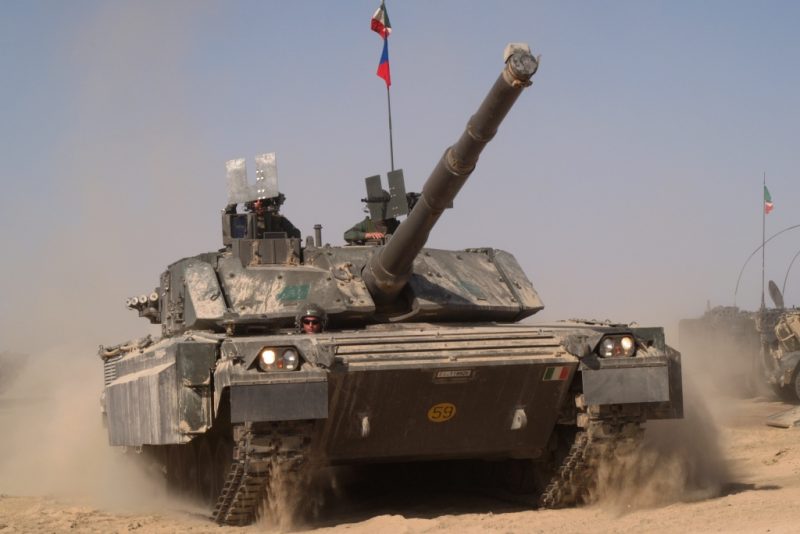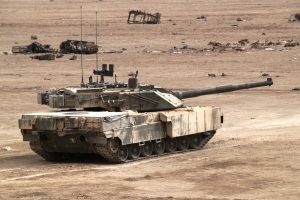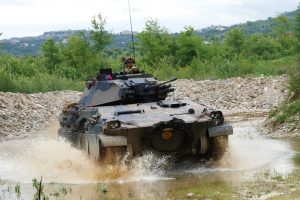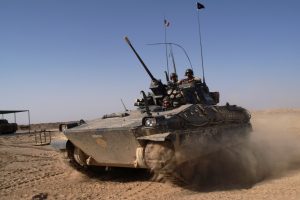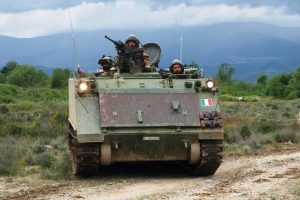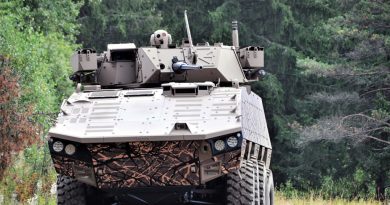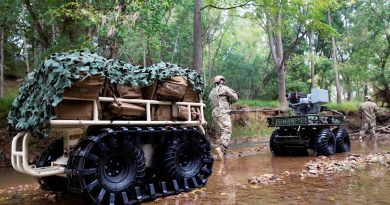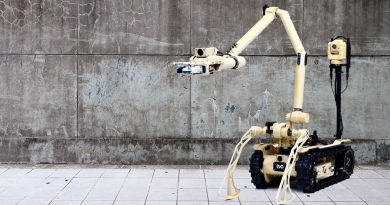Italian Army: towards heavy forces modernisation
The Italian Army is planning to modernise its heavy brigades, splitting the programme in two phases. The first one, seen as an interim solution, is based on the upgrade of the legacy fleet of vehicles, which are the Ariete MBT, the Dardo AIFV, and a series of specialised versions of the M113 in the combat and combat service support roles that operate in mechanised infantry regiments alongside with the Dardo.
Based on available information, the Ariete MLU is the most advanced of those programmes, as the first firing of prototype #1 took place on September 30th 2022, industry planning to deliver the three scheduled prototypes to the service within January 2023 to start qualification trials. The main upgrades include the replacement of the powerpack with a new one based on a 1,500+ hp diesel engine, a new more powerful braking system, the upgrade of a number of mechanical elements, the adoption of 3rd generation all digital gunner’s sight and commander’s panoramic sight, the transformation of the turret in an all-electric system, the installation of a new command and control system, of an improved Mine Protection Kit (MPK), and of wider tracks. The upgraded Ariete will be fitted with armour according to the mission, the lighter version being the basic one with the MPK installed, followed bi the War, mostly add-on armour on the frontal arc, Peace Support Operations (PSO) Light, with increased protections against RPGs on the side, War plus MPK, and finally PSO plus MPK, Military Load Classification ranging from 63 of the lighter version up to 70 of the heavier one, which corresponds to a 62.5 tonnes combat weight. Industry is currently busy in finalising the proposal for the production contract, worth 848 million Euro, that will see the upgrade of 125 Ariete MBTs on the total of 200 tanks originally produced. As for the Dardo IFV, the initial package looks at solving obsolescence issues, a possible powerpack replacement, based on a more modern diesel commonrail engine that would provide the same 520 hp output but with a higher torque, the Army also looking at a low-cost commander’s panoramic periscope. Overall 135 Dardo should be refurbished, while 159 M113 will also undergo an upgrade to allow them to remain effective until the deployment of a future vehicle.
Starting his presentation at the Armoured Vehicles Eastern Europe Conference, which took place on September 27-28 in Warsaw organised by Defence IQ, Lt.Gen. Gaetano Zauner, Deputy Chief of Staff Italian Army, confirmed that, “In the short/mid-term we will modernise as much as possible our legacy systems,” adding that as a second step his service is considering a new generation combat capability. “While carrying out the first phase of the programme we are testing a new approach in our relationship with the industry, Italian or international,” adding, “We leave behind us the very strict key performance parameters system adopted until now, and instead we identify high level requirements that we share with our industrial partners in order to adopt a correct approach that allows us to exactly understand which is the industry capability to produce and support the system required, and if that capability meets our timeline. We had already some successful examples and we will follow this path also for future procurements.”
According to data provided, the second step of the programme will include the acquisition of over 1,000 armoured vehicles of different types, its cost being evaluated at over 20 billion Euro. This programme will come to fruition from 2035 on and will include new MBTs, the main part of it being however centred on a new modular tracked platform, dubbed AICS (Armoured Infantry Combat System) in official papers, which will give birth to a whole family of vehicles. Considering the evolving battlefield scenario, those platforms will not face only typical kinetic threats, but also non-kinetic effectors in the form of electronic warfare and cyber attacks, which can disrupt those technological advantages provided by networking, the use of artificial intelligence-based algorithms and other new and disrupting technologies.
“We will develop a complete capability of heavy forces in terms of combat, combat support and combat service support platforms,” Lt.Gen. Zauner says. Apart from the main battle tank, it is clear that the Italian Army looks at a complete family of vehicles based on the same modular tracked platform that will adopt the NGVA (NATO Generic Vehicles Architecture) based on STANAG 4574. This new platform will feature improved performances in the three key areas of an armoured vehicle, mobility, protection and firepower, will be interoperable by design, will have a considerable growth potential, not only in terms of increased weight but also in terms of integration of emerging technologies, will have a man/unmanned teaming capacity, and will be sustainable.
The approach of considering mission modules to be fitted to the AICS chassis follows the current trend adopted on some tracked and wheeled vehicles of the latest generation, and might favour another key point raised by the Italian Army DCOS. “Our aim is to get battlegroup packages of vehicles, which will include the required number of platforms in their different versions in order to fully equip the earmarked unit.” This will allow having a battlegroup that can start training as soon as it gets its new assets, and have it operational in the shortest possible time, while when acquiring vehicles by types the whole force is not fully operational until the last vehicle is delivered. Mission modules coupled to the platform will provide 12 different versions, Combat, Heavy Mortar, Armoured Personnel Carrier, Engineer, Air Defence, Ambulance, Reconnaissance, Command Post, Logistic Carrier, Antitank, Fire Support and Driver Trainer. Until now Italian Army formations suffered of a lack of homogeneity, as they had state-of-the-art systems in some areas and obsolescent systems in others, which produced a reduced combat capability. While other services, for example the Navy, acquired by definition a complete system, the ship, the Army could not do the same. The identification of the battlegroup as the basic pawn of the Army combat capability should allow overcoming that problem.
The AICS design phase will therefore see all the prototypes being developed at the same time in order to qualify the whole family, production being launched with the right number of platforms and modules to cope with the battlegroup tables of organisation. According to a slide shown during the Warsaw conference, a typical mechanised battlegroup will be composed of a reconnaissance squadron, two mechanised infantry companies, one mechanised combat support company, one tank squadron, one self-propelled artillery battery, one engineer company and one air defence platoon. EDR On-Line understood that the organisation shown is an example of what a battlegroup might look like, the actual organisation being tailored to the mission and the terrain. The slide shows the battlegroup HQ and the HQ Company, each with two command post vehicles.
The reconnaissance company is the only formation within to be equipped with wheeled vehicles, as it fields two mixed platoons with two Centauro II armoured cars and four lighter 4×4 recce vehicles, plus rotary wing unmanned air systems (UAS) and in perspective unmanned ground vehicles (UGVs), and a heavy recce platoon with four Centauro II. However, talking to EDR On-Line, Lt.Gen. Zauner said that Army intends avoiding mixing tracks and wheels. EDR On-Line understood that a reconnaissance version of the new tracked platform might be developed, as it should be able to accept a 120 mm turret. However as an interim solution such a turret might be installed on a Leopard 1A5 chassis. The Army sold those MBTs to industry some years ago, but they are still in Italy, mothballed and parked in that company. From a logistic standpoint the chassis would be sustainable, the service having still in service a number of specialised versions, engineer, pioneer, bridgelayer and recovery.
Coming to combat elements, each Mechanised Infantry Company will deploy three platoons with four Infantry Combat Vehicles (ICV) each, and one Mechanised Infantry Support Platoon with a Forward Observation element, three heavy mortar vehicles and two antitank vehicles, to which we must add two ICVs, one for the Company Commander and one for his/her deputy. The Mechanised Infantry Support Company includes a sniper section, a Heavy Mortar Platoon with its Forward Observation element, with a version of the AICS adapted to carry the FOO equipment, and four heavy mortar vehicles probably fitted with the same 2R2M (Rifled Recoiled Mounted Mortar) 120 mm automatic laying system already installed on the Freccia 8×8 mortar carrier, a Reconnaissance Platoon on three recce manned vehicles complemented by fixed-wing UAS and UGVs, and an Antitank Platoon on four vehicles, which will potentially employ the Spike LR2, should no newer systems of that category appear in the mid-term future. The Tank Squadron will field three four-tank platoons, to which we must add that of the squadron commander; which will be the Italian Army MBT in 2035 is difficult to predict, considering the turmoil that currently affects the main European programme in this field.
Coming to combat supports, the Artillery Battery brings heavy indirect fire directly within the battlegroup. Italy heavy brigades currently fields the PzH 2000 SP howitzer, which is more than adequate and will soon be the subject of an upgrade that will also allow it to programme the new Vulcano long range guided ammunition under armour. The battery will also include a Joint Fire Support Team (JSFT) element with two specialised vehicles, always based on the AICS platform. The Mechanised Engineer Company will have four platoons, two Combat Engineer Platoons with the basic engineer vehicle, three each, fitted among others with a dozer blade, one Mobility Platoon that will take care of obstacle crossing thanks to two platforms fitted with a mine-clearing roller system and two other platforms fitted with a rapid deployable bridging system, and finally the Advanced Combat Engineer Reconnaissance Platoon, with three engineer vehicles fitted with specific C-IED systems, fixed-wing UAS and UGVs. Last but not least the air defence platoon with a total of five vehicles. No details are currently available on the type of effectors that will be installed on those platforms, however their task will certainly be to provide VSHORAD against air breathing targets, as well as C-UAS and C-.RAM protection.
Overall this battlegroup will deploy around 80 vehicles based on the new AICS modular tracked platform.
This organisation, albeit provisional, marks the full commitment of the Italian Army to the Combined Arms approach, which goes down to the minimum organic level. The Italian Army order of battle will not change, the two heavy Brigades remaining the “Ariete” Armoured Brigade and the “Garibaldi” Mechanised (Bersaglieri) Brigade, each fielding three combat regiments, respectively two tank and one mechanised infantry the former and the opposite numbers the latter. Each brigade should be able to form two battlegroups, while maintaining some reserves, the only non-organic element being the air defence platoon, if current tables of organisation will not be modified.
“Of course we wish the AICS programme will become multinational, in order to share non recurrent costs and to build common logistic chains of supply. It would also mean having an inherent interoperability among allies and maximise integration among the many multinational formations within the European Union,” Lt.Gen. Zauner stresses. The aim is to involve solid international industrial partners, allowing transfer of technology and local production, maintenance and upgrade in nations that would joint the programme, possibly putting the programme under the auspices of a multinational procurement agency, such as for example the OCCAR.
One key element, according to the Italian Army DCOS, will also be leadership training. “We need to educate future leaders to put the next generation of technologies and warfighting into a digital context, but beside that we have some ethical issues that remain of paramount importance in the modern battlefield. I think that the soldier remains the pivotal resource when we have to achieve our mission on the battlefield,” Lt.Gen Zauner concludes.
Photos courtesy P. Valpolini

